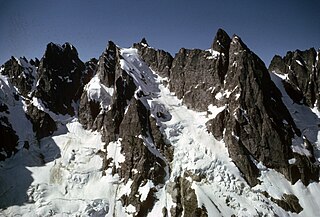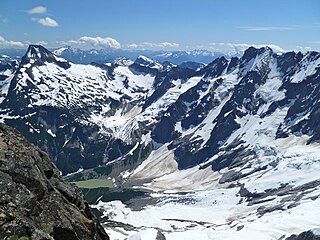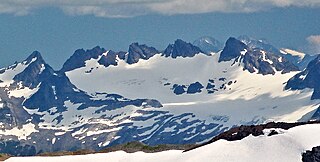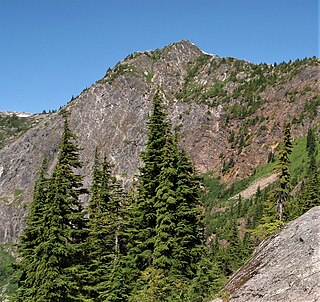
Mount Terror is a mountain of the Cascade Range, located in the northwestern corner of Washington in Whatcom County. The peak is in North Cascades National Park, about 15.7 miles (25.3 km) south of the Canada–United States border.

Bacon Peak is a mountain located in North Cascades National Park, in the Cascade range in the U.S. state of Washington. Its glaciers cover 1.2 square miles (3.2 km2); the three main glaciers are Diobsud Creek Glacier, Green Lake Glacier and Noisy Creek Glacier.

Mount Logan is located in North Cascades National Park in the U.S. state of Washington. Mount Logan is in a remote location of North Cascades National Park that requires hiking 20 mi (32 km) from a trailhead to reach the peak. The mountain itself is not a difficult climb, though the easiest approaches require traversing glaciers and ropes are recommended. The peak supports three glaciers including Banded Glacier to the north, Fremont Glacier to the southwest and Douglas Glacier on the southeast slopes.

Klawatti Peak is located in North Cascades National Park in the U.S. state of Washington. Klawatti Peak is a nunatak, a peak surrounded by glaciers. These are Klawatti Glacier to the east, McAllister Glacier to the northwest and Inspiration Glacier to the south.

Mount Hinman is located on the border of Snoqualmie and Wenatchee National Forests in the U.S. state of Washington. Mount Hinman is less than 2 mi (3.2 km) west of Mount Daniel and both are within the Alpine Lakes Wilderness. Hinman Glacier is situated on the north flank of Mount Hinman and Foss Glacier is to the northeast. The mountain was named in 1934 for Dr. Harry B. Hinman, a founder of the Everett branch of The Mountaineers club.

Sinister Peak is in Mount Baker-Snoqualmie and Wenatchee National Forests in the U.S. state of Washington. It is situated in Glacier Peak Wilderness and the North Cascades. Not quite 1 mi (1.6 km) east of Dome Peak, Sinister Peak is along a high ridge connecting the two peaks. The Chickamin Glacier is on the north slopes of Sinister Peak while the Garden Glacier is just southeast. Though some of the routes to the summit are technical, it can be reached by a moderate scramble.

Whatcom Peak is in North Cascades National Park in the U.S. state of Washington. Whatcom Peak is .50 mi (0.80 km) north of Challenger Glacier and the Whatcom Glacier descends from the northeast slopes of the peak. An unnamed hanging glacier descends along the northwest flank of the peak. This mountain is set between Mount Challenger and Easy Peak.

Cosho Peak is in North Cascades National Park in the U.S. state of Washington. Cosho Peak is a summit along a ridge known as Ragged Ridge and the Kimtah Glacier is on the northeast slopes of the peak.

Kimtah Peak, elevation 8,600+ feet, is in North Cascades National Park in the U.S. state of Washington. Kimtah Peak is a summit along a ridge known as Ragged Ridge. Kimtah Glacier is on the northwest slopes of the peak, while Katsuk Glacier is to the northeast.

Mount Fury, elevation 8,356+ ft, is in North Cascades National Park in the U.S. state of Washington. Several small glaciers are on the slopes of Mount Fury, and it is the highest peak in the Picket Range. A theodolite survey of West and East Fury on Oct 22, 2022, established the altitudes of the two peaks of Fury. West Fury was set at 8,305ft +/-10 feet and East Fury as 8,356 +/- 8ft. This makes East Fury one of the 100 highest peaks in the State of Washington. Luna is now the second highest peak in the Picket Range.

Mount Rahm is in North Cascades National Park in the U.S. state of Washington. Located in the northern section of the park, Mount Rahm is less than .25 mi (0.40 km) south of the Canada–United States border, just north of Silver Lake, and 2 mi (3.2 km) north-northeast of Mount Spickard. The peak is estimated to be between 8,485 and 8,525 ft above sea level, and it sits at the northeastern end of Custer Ridge. Mount Rahm was named after Dr. David Allan Rahm (1931–1976), author and professor, who published and lectured about the geology of the surrounding area.

Mox Peaks is in North Cascades National Park in the U.S. state of Washington. Located in the northern section of the park, Mox Peaks consist of several summits in close proximity to each other that are nearly the same altitude, but the highest point is the eastern peak. Mox Peaks West looms just to the southeast of Redoubt Glacier and is at the southern terminus of a long arête which extends 1.75 mi (2.82 km) to Mount Spickard to the northeast. A deep col lies between Mox Peaks High Point and Mox Peaks West.

Crooked Thumb Peak is located in North Cascades National Park in the U.S. state of Washington. Located in the northern section of the park, Crooked Thumb Peak is in the Picket Range and is .50 mi (0.80 km) south of Mount Challenger and the same distance north of Phantom Peak.

Mount Degenhardt, elevation 8,000+ ft, is a mountain peak in the Picket Range in the U.S. state of Washington and within North Cascades National Park. Located in the northern section of the park, Mount Degenhardt is .30 mi (0.48 km) southeast of Mount Terror, .28 mi (0.45 km) west of Inspiration Peak. and .75 mi (1.21 km) west of McMillan Spire. Mount Degenhardt is named after William Degenhardt, an early 20th century mountain climber. The Terror Glacier lies on the southeast slopes of Mount Degenhardt.

McMillan Spire is a mountain peak in the Picket Range in the U.S. state of Washington and within North Cascades National Park. The peak lies .75 mi (1.21 km) east of Mount Degenhardt, and 0.47 mi (0.76 km) east of Inspiration Peak. The subpeak known as East McMillan Spire is .14 mi (0.23 km) east of McMillan Spire and they are collectively referred to as the McMillan Spires. The Terror Glacier lies to the west of the peak.

Sourdough Mountain is in North Cascades National Park in the U.S. state of Washington. The Sourdough Mountain Lookout, is a fire lookout that was built by the Civilian Conservation Corps in 1933 near the summit. The lookout was placed on the National Register of Historic Places in 1989.

The Chopping Block is a 6,819-foot (2,078-metre) mountain summit located in the Picket Range within North Cascades National Park in the state of Washington. The mountain is officially named Pinnacle Peak on maps, but hardly anyone calls it by that name. The nearest higher peak is Mount Degenhardt, 0.6 mi (0.97 km) to the northeast. The Chopping Block can be seen from the North Cascades National Park Newhalem visitor center, weather permitting. Precipitation runoff from the peak drains into Goodell Creek, a tributary of the Skagit River.

Hagan Mountain is a multi-peak mountain located in Whatcom County, Washington state, within North Cascades National Park. It has an elevation of 7,080-foot (2,160-metre). The mountain is situated approximately 12 mi (19 km) north of Marblemount.

Nodoubt Peak is a remote 7,290-foot (2,220-metre) mountain summit in the Skagit Range of the North Cascades of Washington state. Nodoubt Peak is situated in North Cascades National Park, 2.2 kilometres south of the Canada–United States border. Its nearest higher peak is Canuck Peak, 1.43 mi (2.30 km) to the southeast, and Mount Redoubt rises 3.04 mi (4.89 km) also to the southeast of Nodoubt. Nodoubt Peak was named by a group of geologists who climbed the peak in 1967. Its name is a word play on Mount Redoubt's name. Precipitation runoff from Nodoubt Peak drains into tributaries of the Chilliwack River.

Trappers Peak is a 5,966-foot (1,818 m) elevation mountain summit located in the North Cascades of Washington state. It is situated within North Cascades National Park, Stephen Mather Wilderness, and Whatcom County. It rises steeply above Lower Thornton Lake which is set at the southwestern face of the mountain. Like many North Cascades peaks, Trappers Peak is more notable for its large, steep rise above local terrain than for its absolute elevation. Topographic relief is significant as the southeast aspect rises 5,500 feet (1,700 m) above the North Cascades Highway in approximately two miles. The nearest higher neighbor is Thornton Peak, 1.5 miles (2.4 km) to the northwest, Mount Triumph is two miles to the northwest, and Newhalem is three miles to the east-southeast. Precipitation runoff from the mountain drains into tributaries of the Skagit River. The summit of Trappers Peak is known for its grand view of the jagged peaks of the Picket Range.























